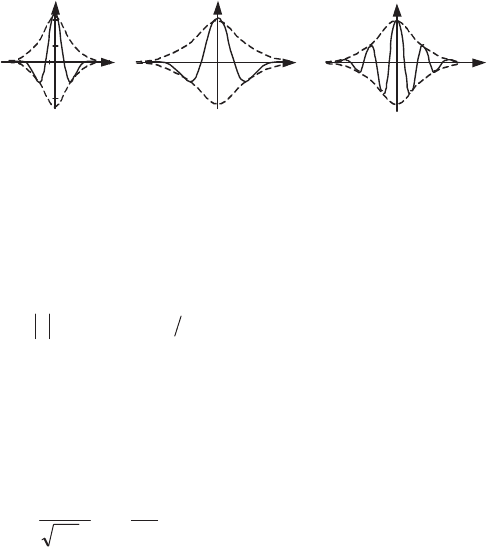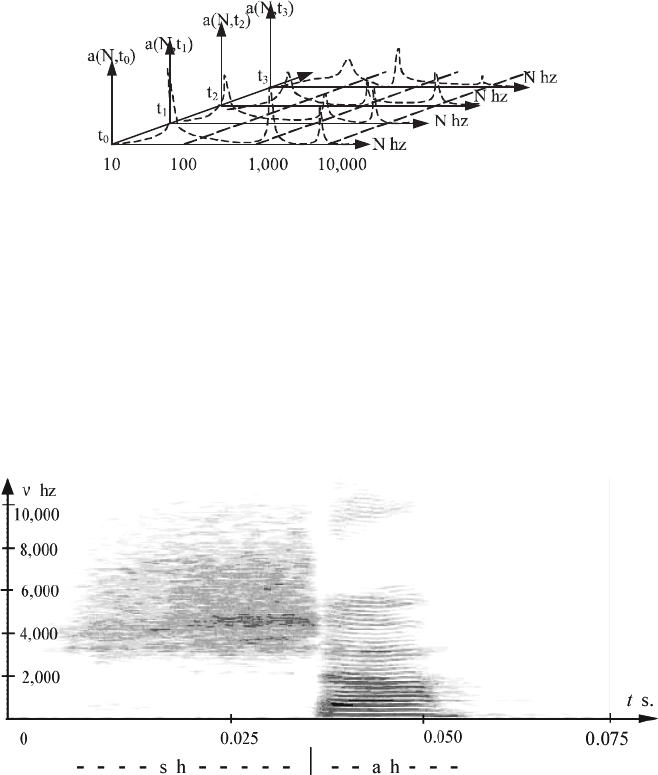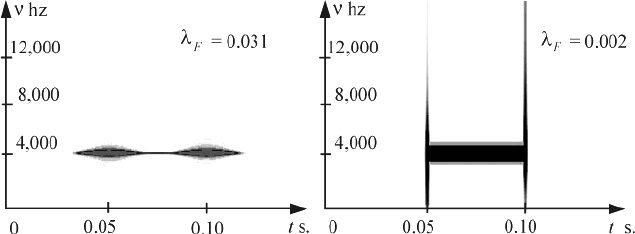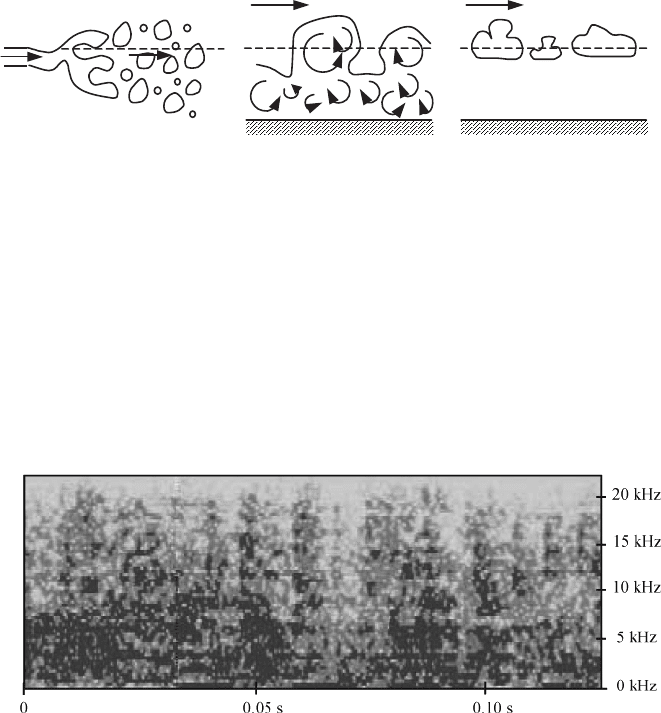Peube J-L. Fundamentals of fluid mechanics and transport phenomena
Подождите немного. Документ загружается.


Measurement, Representation and Analysis of Temporal Signals 373
In practice, the effective choice of a window results from the ensemble of
various considerations. For a presentation and comparison of commonly used
windows, the reader should refer to ([BAH 01], [MAD 98], [NOR 03], [STR 96]
[MAX 96]).
7.3.4.7.
Continuous wavelet transforms
7.3.4.7.1.
Introduction
The Fourier transform with a window function can also be interpreted as an
integral transform whose kernel is the product
tj
T
et
SQ
2
)() of the complex
exponential
tj
e
SQ2
by the window
t
T
) . In other words, we no longer perform a
Fourier transform over a limited duration; rather, we perform a transform with a
function
tj
T
ettg
SQ
Q
2
)(, ) that is different from the complex exponential. Such
a function is often called a wavelet.
This point of view can be generalized by considering functions of time that
contain additional parameters such as window width, which can depend on the
frequency. An example is the Gabor transform in which we decompose the signal
studied according to a basis of functions comprising the product of the complex
exponential
tj
e
SQ2
and Gauss windows of width
D
, centered here at the origin:
dttxeeG
tjt
x
³
f
f
SQD
DS
QD
24/
2
2
1
,
In the Gabor transform, we thus have as an additional parameter the width
D
of
the window; we obtain, after transformation, a function with two variables which
provide redundant information for representation of the signal x (t). The frequency
representation studied in section 7.3.4.6 can be obtained by fixing the value of
window width; by varying this, we can obtain complementary information. Consider
for example a signal comprising one or two periods of a harmonic function of a
given frequency that is centered at the origin. Let us apply the Gabor transform, we
obtain a new transform which is not so different from the previous one, so long as
the analysis window has a width
D
of the order of that of the preceding signal, but if
this window is widened, the value of the transform will be reduced. A Gabor
transform with variable width allows the length of a signal to be identified.
7.3.4.7.2. Timescale transforms
We thus arrive at the idea that by using window width as a variable of the
analysis wavelet, we can obtain information regarding the timescales of the signal.
We thus use an analysis wavelet whose form is conserved when we dilate the

374 Fundamentals of Fluid Mechanics and Transport Phenomena
window width. It is clear that by proceeding in this way, the physical idea of
frequency is no longer so clear. If the window comprises little oscillation, then it is
its size that will be the pertinent variable for the transform.
(a) (b) (c)
t t t
Figure 7.10. Wavelets with variable width ((a) and (b))
or variable frequency ((b) and (c))
We define the transform T
s
(a) of the signal s(t) by the wavelet h(t/a):
dtathtsaaT
s
³
f
f
)(
2/1
in which the transform variable is the scale a.
A simple wavelet is the “Mexican hat” wavelet, which is the second derivative
of the Gauss function:
22
2/
2
2
1
2
1
,
at
e
a
t
a
ath
¸
¸
¹
·
¨
¨
©
§
S
Figure 7.10 shows the window variations for a timescale analysis (windows a
and b) and for a time-frequency analysis (windows b and c).
Diverse problems arise in the choice of wavelets and in particular for the
reconstruction of a signal from its transform ([ALL 04], [FLA 77], [MIS 07], [STR
96]).
7.3.5. Time-frequency (or timescale) representations
7.3.5.1.
General principles
The representation of a signal x(t) by means of an integral transform is useful so
long as this is not too different from the transform kernel: very short signals
centered at the origin will be well represented by wavelets, whereas the Fourier

Measurement, Representation and Analysis of Temporal Signals 375
representation is better suited to periodic (or nearly periodic) signals. For other
signals the preceding representations are numerically ill-conditioned.
Let us take the example of a centered signal of length 100 and which comprises
two sequences of oscillation (Figure 7.11) separated by a sequence in which the
signal is zero. Its representation by means of a Fourier series on the interval [-50,50]
(after change of time origin) is theoretically possible, but it will require a series with
so many coefficients that if will not be very useful.
x(t)
0
t
50 –50
Figure 7.11.
Intermittent signal comprising two different sequences
The use of a Fourier transform in the same window will hardly be more
satisfactory. The use of a Fourier transform with window functions would be even
worse on account of signal attenuation towards the window edges. Furthermore, the
(complex) transforms will not indicate in a simple manner the fact that the signal
comprises two sequences of different frequencies at distinct instants, rather than a
uniformly distributed frequency content. We can also think of performing two
Fourier transforms on the separate intervals, but such a procedure is directly related
to the signal structure and so cannot be easily generalized.
The most direct representation thus consists of recording the signal by means of
a window function which is centered on the instant
W
, and then performing a short-
time Fourier transform. We are thus led to perform sliding transforms, which allow
the identification of the spectral content of signals contained in the window ) (t -
W
).
This sliding Fourier transform is expressed:
f
dtet
x
t
)
F
t
j
x
Q
S
W
W
Q
2
)()( ) , (
f
)
³
The transform ),(
W
Q
)x
F is a function of two variables
W
and
Q
which we will
qualify as a time-frequency representation. The spectral distributions become
functions of time. However, such a continuous representation contains much
redundant information concerning the signal x(t) since knowledge of a single
transform on the time interval of the signal suffices for a reconstruction of the initial
signal.

376 Fundamentals of Fluid Mechanics and Transport Phenomena
7.3.5.2.
Practical applications
A natural solution for reducing the size of the time-frequency representation thus
consists of performing a partition of the total study interval into n temporal
segments each of a length 't in the order of the window width, and only conserving
the Fourier transforms performed at the center of the segments. We thus obtain a
succession of spectra, each of which can be attributed to a given instant.
Figure 7.12.
Spectrogram
The representation of these spectra in the form of a succession of spectra as a
function of time is known as a spectrogram (Figure 7.12). However, a spectrogram
can quickly become quite complex and difficult to read for long signals. We often
prefer a representation, known as a sonogram, where the values are shown in the
time-frequency plane where the use of color or grayscale allows the indication of the
signal level. In this way the information contained in the signal can be visualized in
terms of the evolution of the frequencies and amplitudes.
Figure 7.13.
Sonogram of the word “shah” pronounced by a person

Measurement, Representation and Analysis of Temporal Signals 377
Sonograms (often known as spectrograms) are very often used for the analysis of
complex signals; Figure 7.13 shows the sonogram of an acoustic signal
corresponding to the word “shah”. We can note that the ensemble of letters “sh”
corresponds to higher frequencies than the ensemble “ah”.
The considerations of section 7.3.4.6, relating to the time-frequency uncertainty,
here applies and the Heisenberg-Gabor inequality indicated earlier remains valid: a
precise temporal localization and an accurate analysis are incompatible. This
phenomenon is illustrated by Figure 7.14. which presents sonograms of a signal
composed of a silence of 0.05 second duration, followed by a harmonic oscillation
of frequency 4 kHz during 0.05 seconds, and then, once again a silence. The
analyses performed by means of the software COOL EDIT with windows of width
A
F
respectively equal to 0.031 and 0.002 seconds show that the first value allows a
suitable identification of the frequency, whereas the second allows a better temporal
localization of the portions of the signal. The Blackmann-Harris window used gave
better results than the other windows that were available; however, the reader
should remember that the choice of window depends on empirical considerations
([ALL 04], [JUR 08], [MAD 98], [STR 96], [WAI 90]).
Figure 7.14.
Influence of the width
A
F
of the Fourier window
on the sonogram (4,000 Hz)
The explanations which have just been provided for the time-frequency analysis
can be transposed to timescale analysis. This domain is more common in image
treatment; the interested reader should see specialized texts on this subject. The
principle of time-frequency representation can be applied in two dimensions, the
frequency or scale spectra being thus functions of two variables.

378 Fundamentals of Fluid Mechanics and Transport Phenomena
7.3.5.3.
Regarding multiple timescales
The fact that spatial or temporal variations of a phenomenon take place at two
completely different scales has important but variable consequences depending on
the mathematical form of the variations. If these are relatively uniform and non-
oscillatory, we have a singular perturbation problem (see section 6.4.3). For
oscillations of a linear system, the preceding time-frequency analysis is only
meaningful if the notion of frequency can be defined, in order to allow separate
identification of the rapid component (short oscillation period) and the slow
component (characteristic time of the amplitude and phase variation, etc. (section
7.3.4.4)).
These notions of fast and slow scales are not however so easy to define. Let us
consider the example of a signal s(t), which is the sum of two harmonic signals of
close frequencies NN G
0
and NN G
0
:
tNtNtNNtNNts GSS GSGS 2cos.2cos
2
1
2cos2cos)(
000
This expression shows that s(t) can be considered as a harmonic signal
tN
0
2cos S with fast variations, whose amplitude is slowly modulated by the
function tNGS2cos . The two timescales are here clearly 1/N and 1/GN. The
amplitude modulation can be any broadband slow signal a(t) as in the transmission
of radio waves.
Frequency modulation is also a system with two timescales, with a low-
frequency carrier signal N
0
and a slow variation of frequency GN:
.2cos)(
0
ttNNts GS
The spectrum of this signal modulated with frequency tNtN
Z
G
G
cos)((
0
is
not very different from the amplitude modulated spectrum: in addition to the two
close frequencies
N
N
G
0
0
and
N
N
G
0
0
, it contains only a small number of
weak peaks.
The amplitude spectra of amplitude and frequency modulated signals are nearly
similar, but the temporal signals and the phase spectra have very different structures.
This comparison illustrates the difficulty of reconstructing, with its detailed
characteristics, the time signal which corresponds to an amplitude or energy
spectrum: theoretically only the temporal and complex spectral representations are
completely equivalent. More generally, a signal similar to a harmonic signal of

Measurement, Representation and Analysis of Temporal Signals 379
frequency N
0
can be studied with Hilbert transform, amplitude and frequency
modulations being defined from its analytical signal (section 7.3.4.4).
In practice, signals used in telecommunications are modulated in amplitude or in
frequency by a low frequency signal, which contains information to be transmitted
and decoded. In mechanical or energetic systems, these modulations are the result,
either of the presence of two close frequencies, or of a slow oscillatory variation of
the physical characteristics of an oscillator (stiffness or length of a vibrating system,
for example, or interaction between structures of different frequencies in fluid
mechanics or acoustics).
We will re-encounter the problem of multiple time (and space) scales in
turbulent fluids, at the heart of which are fluctuations of central importance. An
everyday example can be found for flow in the atmosphere: the wind presents
instantaneous fluctuations with very short periods (a couple of seconds for gusts of
wind), and longer periods (from many hours to a day for perturbations (in the
meteorological sense)) which are relatively individual structures at the atmospheric
scale. These two categories of scale are generally distinct and we can thus separate
meteorological and turbulence phenomena by performing statistics for the mean
values at the scale of the turbulent fluctuations. Meteorological predictions and data
provide the mean velocity, the effect of fluctuations due to gusts being smoothed at
timescales of a fraction of an hour.
On the other hand, turbulence frequencies have a continuous spectrum and the
temporal separation of phenomena is hazardous in proportion to the degree of non-
linearity of the turbulence mechanisms. Furthermore, the corresponding flows can
nonetheless be subject to temporal variations at a slower scale due to influences
other than that of the turbulence.
7.3.5.4.
Study of intermittency
We call intermittency that property of a signal that comprises structures of the
same nature, which occur at intervals that may be more or less regular or random.
The signal is comprised of “packets” with a specific structure different from the
characteristics of the rest of the signal (Figure 7.15).
x
(
t
)
0
t
Figure 7.15.
Example of intermittent signal

380 Fundamentals of Fluid Mechanics and Transport Phenomena
Intermittency is encountered in many flows; for example, Figure 7.16 shows that
a fixed observer at the horizontal level N will perform measurements characterized
by intermittency for liquid packets in a water jet (a), the external turbulent zones of
a boundary layer (b), or ascending currents in clouds which are carried by the wind
(c).
F
U U
(a) (b) (c)
NN
N
Figure 7.16.
Intermittency phenomena in: (a) a liquid jet; (b) in the frontier zone of a
turbulent boundary layer; (c) in atmospheric flow with cumulus
Figure 7.17 shows the sonogram of a sound recording of a water flow that issues
from a floater tap in which a rapid liquid jet bursts in an air pocket which is trapped
at the top of a vertical pipe before filling a reservoir. The impact of the liquid
packets on the walls is particularly loud and is translated by dark regions on the
sonogram. When the air pocket is purged, all that remains is the sound produced by
the turbulence in the water which is much less noisy, and the sonogram is thus a
relatively uniform shade of gray.
Figure 7.17.
Sonogram of the noise of a flow of water with
air pockets downstream a tap
Measurement, Representation and Analysis of Temporal Signals 381
In general, the emission of sound in a flow is always associated with unsteady
structures. This is a frequent nuisance, easily identified by an attentive ear, that we
seek to eliminate. The analysis of flow noise with the signal processing techniques
discussed above, and in particular time-frequency analysis, often allows the
identification and improvement of noisy regions of a flow. These procedures merit
broader use, but they require relatively complete knowledge in the domains of fluid
mechanics and acoustics.
7.3.6. Discretized signals
7.3.6.1. Evolution of techniques
While physical quantities are represented by real or complex numbers with
continuous values, the results of experiments are truncated decimal approximations,
which are subject to the uncertainties of the experiment. Since the earliest scientific
developments, it is the experimenter himself who discretizes the values of the
measurements he performs. In the same way numerical applications of the
equations, which result from exact or empirical theories, can only be used with
discretized, truncated numerical values. The introduction of computer technology
has completely modified both experimental techniques and the practice of system
modeling.
The evolution of experimental and measurement methods has been marked by
two types of devices, depending on the nature of the electronic treatment:
– analog devices in which the input signal (voltage or electric current) is a
continuous function of time which is then transformed by electronic circuits into an
electrical output signal, which is itself a continuous function of time; in these
devices, mathematical discontinuities don’t really exist. These measurement devices
generally have a relative accuracy associated with the scale chosen for the
measurement;
– digital devices, which use information technology, and operate on signals
constituted of a finite sequence of truncated numerical values (which are encoded in
a number of “bits” or “bytes”). Here, once again, digitization errors (quantification)
are in direct relation with the maximum value chosen for the representation of
numbers (12 or 16 bits for example).
The interest of digital techniques lies in the ease of adaptation and the near
infinite possibilities: any modification in the treatment of a signal is performed
through the modification of a computer program, on the contrary, the modification
of an electric analog circuit can only be achieved through modifying the physical
properties of the components, some of which may be variable by construction
anyway.
382 Fundamentals of Fluid Mechanics and Transport Phenomena
The techniques used in practice are often mixed for different reasons:
– as the initial signals are often continuous, it is necessary to construct a table of
numerical values which we wish to retain by sampling (this is the job of the analog-
to-digital converter);
– the signals which result from a treatment are often destined to be used to act on
analog materials which require a certain power (power amplifiers, actuators,
loudspeakers, etc.); the discontinuities of the numerical values must therefore be
interpolated by means of a digital-to-analog converter which delivers a continuous
electrical signal.
7.3.6.2.
Sampling of continuous signals
The representation of continuous signals by tables of numerical values is only
useful if the initial signal can be reconstructed exactly without any loss of
information. We replace the continuous signal by a sequence of values that are
generally recorded at regular intervals. It is clear that the signal should not have
varied too much between two successive values, such that its reconstruction in a
continuous form can be performed with suitable precision.
The temporal representation of a signal s(t) amounts to its decomposition into a
basis of Dirac functions according to the following property:
WWGW
dtftf
³
f
f
)(
Sampling a signal s(t) comes down to multiplying it by the sampling function
)(
__
t
T
III
(also known as Dirac comb or impulse train) defined by the sum of Dirac
impulses positioned at the points kT (k integer):
integer,)(
__
kt-kTkT
k
k
T
¦
f
f
G
III
We thus have:
() (),integer
k
k
skT tkTstdtk
d
d
d
d
¨
C
The sampling of temporal signals is a complex operation ([BAH 01], [BEL 00],
[CAS 06], [HIG 93], [MAD 98], [MAX 96]).
